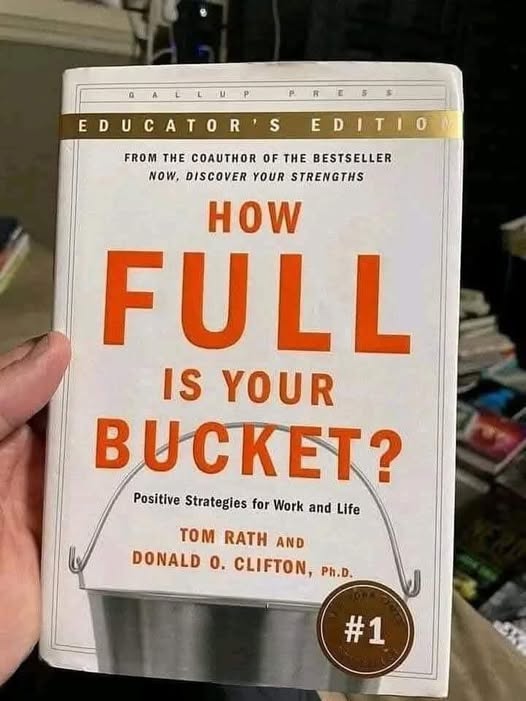
“How Full Is Your Bucket? by Tom Rath and Donald O. Clifton”
How Full Is Your Bucket? explores the profound impact of positivity and negativity on our lives using a simple but powerful metaphor: a bucket and a dipper. Every interaction we experience either fills or drains our emotional “bucket.” Based on research in positive psychology, the book offers actionable strategies to increase positive emotions, enhance relationships, and improve well-being in personal and professional contexts.
Here are some important highlights from the Book.
1. The Bucket and Dipper Metaphor
The central metaphor explains how positive actions fill our emotional bucket, boosting our morale and mental health, while negative actions or words deplete it, leading to stress and dissatisfaction. This concept simplifies understanding the emotional impact of daily interactions.
2. The Power of Positivity
Rath and Clifton highlight that positive emotions significantly enhance physical health, productivity, and relationships. Cultivating positivity not only benefits individuals but also creates a ripple effect that influences those around them.
3. The Impact of Negative Interactions
The book emphasizes that negative experiences can have a stronger emotional impact than positive ones. This underscores the importance of consciously avoiding actions that could drain others’ buckets, whether in conversations or behaviors.
4. Frequent and Genuine Praise
Specific, authentic praise is a key strategy for filling buckets. Recognizing others’ contributions and strengths fosters a positive atmosphere and strengthens bonds, both personally and professionally.
5. Application in Leadership and Management
Managers and leaders are encouraged to use bucket-filling strategies to boost employee engagement and morale. The book provides real-world examples of how positive reinforcement leads to higher productivity and lower turnover rates.
6. The Ratio of Positive to Negative Interactions
Research discussed in the book shows that maintaining a 5:1 ratio of positive to negative interactions is critical for successful relationships and high-performing teams. This balance helps mitigate the damaging effects of negativity.
7. The Role of Self-Filling
Rath and Clifton remind readers that self-care and self-compassion are vital for keeping one’s own bucket full. A person must maintain their emotional well-being to effectively support others.
8. Research-Based Insights and Practical Tools
The book integrates findings from extensive research in psychology and human behavior, offering readers tools and techniques to monitor and improve their bucket-filling habits, including exercises to build emotional intelligence.
In summary
How Full Is Your Bucket? delivers a compelling, research-backed message about the transformative power of positive interactions. With simple yet profound lessons, it inspires readers to cultivate kindness, gratitude, and mindfulness to lead happier and more productive lives.
This book is a valuable resource for anyone seeking to improve relationships and foster a culture of positivity in their personal and professional spheres.